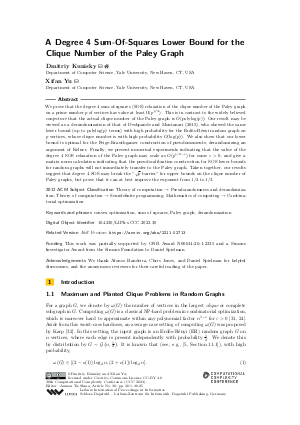@InProceedings{kunisky_et_al:LIPIcs.CCC.2023.30,
author = {Kunisky, Dmitriy and Yu, Xifan},
title = {{A Degree 4 Sum-Of-Squares Lower Bound for the Clique Number of the Paley Graph}},
booktitle = {38th Computational Complexity Conference (CCC 2023)},
pages = {30:1--30:25},
series = {Leibniz International Proceedings in Informatics (LIPIcs)},
ISBN = {978-3-95977-282-2},
ISSN = {1868-8969},
year = {2023},
volume = {264},
editor = {Ta-Shma, Amnon},
publisher = {Schloss Dagstuhl -- Leibniz-Zentrum f{\"u}r Informatik},
address = {Dagstuhl, Germany},
URL = {https://drops.dagstuhl.de/entities/document/10.4230/LIPIcs.CCC.2023.30},
URN = {urn:nbn:de:0030-drops-183008},
doi = {10.4230/LIPIcs.CCC.2023.30},
annote = {Keywords: convex optimization, sum of squares, Paley graph, derandomization}
}

 Creative Commons Attribution 4.0 International license
Creative Commons Attribution 4.0 International license








































